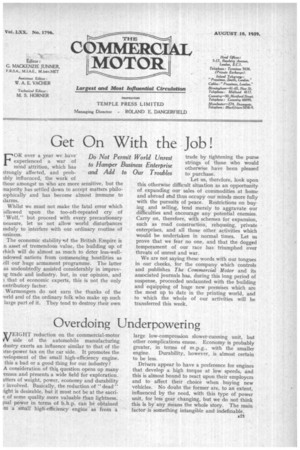Overdoing Underpowering
Page 23

Page 24

If you've noticed an error in this article please click here to report it so we can fix it.
/EIGHT reduction on the commercial-motor Oaf side of the automobile manufacturing dustry exerts an influence similar to that of the nse-power tax on the car side. It promotes the .velopment of the small high-efficiency engine. this a bad or a good thing for our industry?
A consideration of this question opens up many enues and presents a wide field for exploration. afters of weight, power, economy and durability involved. Basically, the reduction of "dead" ight is desirable, but it must not be at the sacrie of some quality more valuable than lightness. pal power in terms of b.h.p. can be obtained hi a small high-efficiency engine as from a large low-compression slower-running unit, but other complications ensue. Economy is probably greater, in terms of m.p.g., with the smaller engine. Durability, however, is almost certain to be less.
Drivers appear to have a preference for engines that develop a high torque at low speeds, and this is almost bound to react upon their employers and to affect their choice when buying new vehicles. No doubt the former are, to an extent, influenced by the need, with this type of power unit, for less gear changing, but we do not think this is by any means the whole story. The main factor is something intangible and indefinable. In our series of road-test reports, during the past 12 months or thereabouts attention has been drawn, from time to time, to the fact that engines with displacements or outputs bordering on the practioable minimum have been installed. Whilst progress must not be retarded, we feel that.manufacturers should beware of losing business (possibly to oversea chassis makers) by concentrating excessively on weight or space saving, price reduction or lessening fuel consumption, by using too small an engine.
Our Editorial Idiosyncrasies
BRILLIANTLY, Mr. A. P. Herbert recently translated Nelson's famous message into what ' an unkind friend described as The Commercial Motor style. During the holiday period, sometimes named the silly season, although chained to our desk, we can smile at ourselves, and here, it seems, is an opportunity.
Primarily we aim, in our style, at lucidity and conciseness, attempting always to write correct English and to preserve a dignity befitting our subject. We have been called pedantic, and if there be justification for this accusation it is . probably because rules, made origiaally to check the abuse of words or phrases or to eradicate loose habits of writing that are too easily acquired, have been slavishly observed.
For example, the word "very" is freely overemployed, largely through laziness in not troubling to think of a more closely defining adverb. It does not often appear in The Commer cial Motor. "And also" is a parallel instance. Nearly always it is redundant to employ both words; only when one is used as a conjunction and the other in an adverbial sense are they togethe; permissible. Such obvious redundancies as hollow tube, round disc, foot pedal never appear on our pages.
Some of our grammatical rules are of our own making and for the 'purpose of uniformity. What else can one do when handling a language that includes such inconsistencies as swing and swung, sing and sang and bough, cough, dough, tough and through? " While " we regard as referring to time, whereas " whilst " is comparative.
Collective nouns—public, crowd, etc.—we correctly treat as entities and therefore singular, and this might suggest pedantry, because the reverse practice is growing. A company is a unity, but we do not extend this view to cases where a few individuals are concerned in a nominal partnership.
For conditional clauses we employ the subjnnctive for emphasis. We write " four-cylindered engine," "big-bodied van," hyphenating to remove ambiguity and using the participle-type adjective to suggest that the main part is equipped with a lesser part.
In V-type, H-girder and S-bend we prefer thE letter to the sound, because the shape iS tit( point—Ess-bend is not nearly so graphic.
Let those mock who will. Our course is tlu harder, but we will stick to it so long as we fee that it is right.




































































